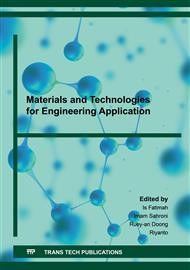[1]
R. Rahmawati, A. Taufiq, A. Sunaryono, A. Fuad, B. Yuliarto, B. Suyatman, and D. Kurniadi, Synthesis of Magnetite (Fe3O4) Nanoparticles from Iron sands by Co-precipitation-Ultrasonic Irradiation Methods, J. Mater. Environ. Sci. 9 (2018) 155-160.
DOI: 10.26872/jmes.2018.9.1.19
Google Scholar
[2]
J. Wallyn, N. Anton, and T.F. Vandamme, Synthesis, Principles, and Properties of Magnetite Nanoparticles for In Vivo Imaging Applications - a Review, Pharmaceutics 11 (2019) 1-29.
DOI: 10.3390/pharmaceutics11110601
Google Scholar
[3]
H Arabi and H.A. Eivari, Applying a suitable route for preparation Fe3O4 nanoparticles by Ammonia and investigation of their physical and different magnetic properties, Int. J. Nano Dimens. 5 (2014) 297-303.
Google Scholar
[4]
U.S. Khan, Amanullah, A. Manan, N. Khan, A. Mahmood, and A. Rahim, Transformation mechanism of magnetite nanoparticles, Materials Science-Poland 33 (2015) 278-285.
DOI: 10.1515/msp-2015-0037
Google Scholar
[5]
H. Kazemzadeh, A. Ataie, and F. Rashchi, Synthesis of Magnetite Nanoparticles by Reverse Coprecipitation, International Journal of Modern Physics: Conference Series, 5 (2012) 160-167.
DOI: 10.1142/s2010194512001973
Google Scholar
[6]
M. C. Mascolo, Y. Pei, and A. Terry. Ring, Room Temperature Co-Precipitation Synthesis of Magnetite Nanoparticles in a Large pH Window with Different Bases, Materials 6 (2013) 5549-5567.
DOI: 10.3390/ma6125549
Google Scholar
[7]
T. Ahn, J.H. Kim, H.M. Yang, J.W. Lee, and J.D. Kim, Formation Pathways of Magnetite Nanoparticles by Coprecipitation Method, J. Phys. Chem. C. 116 (2012) 6069−6076.
DOI: 10.1021/jp211843g
Google Scholar
[8]
H. Aono, H. Hirazawa, T. Naohara, T. Maehara, H. Kikkawa, and Y. Watanabe, Synthesis of Fine Magnetite Powder Using Reverse Coprecipitation Method and Its Heating Properties by Applying AC Magnetic Field, Materials Research Bulletin 40 (2005) 1126-1135.
DOI: 10.1016/j.materresbull.2005.03.014
Google Scholar
[9]
H. Kazemzadeh, A. Ataie, and F. Rashchi, In Situ Synthesis of Silica-Coated Magnetite Nanoparticles by Reverse Coprecipitation Method, Supercond. Nov. Magn. 25 (2012) 2803-2808.
DOI: 10.1007/s10948-011-1270-x
Google Scholar
[10]
A.M. Atta, H.A. Al-Lohedan, A.O. Ezzat, and A.M. Tawfik, Preparation and Surface Properties of Amphiphilic Green Magnetite Nanoparticles Capped with Branched Ionic Liquid, J. OptoElectron. Biomed. Mater. 8 (2016) 61-73.
Google Scholar
[11]
A. Bandhu, S. Sutradhar, S. Mukherjee, J.M. Grenache, and P.K. Chakrabarti, Synthesis, Characterization and Magnetic Property of Maghemite ( g-Fe2O3) Nanoparticles and Their Protective Coating with Pepsin for Bio-Functionalization, Materials Research Bulletin 70 (2015) 145–154.
DOI: 10.1016/j.materresbull.2015.04.035
Google Scholar
[12]
S. Wu, J. Lu, Z. Ding, N. Li, F. F. Fu, and B. Tang, Cr(VI) Removal by Mesoporous FeOOH Polymorphs: Performance and Mechanism, RSC Adv. 6 (2016) 82118-82130.
DOI: 10.1039/c6ra14522a
Google Scholar
[13]
W. Kim, C.Y. Suh, S.W. Cho, K.M. Roh, H. Kwon, K. Song, I.J. Shon, A New Method for The Identification and Quantification of Magnetite-Maghemite Mixture Using Conventional X-Ray Diffraction Technique, Talanta 94 (2012) 348- 352.
DOI: 10.1016/j.talanta.2012.03.001
Google Scholar
[14]
C.V. Yerin, Particles Size Distribution in Diluted Magnetic Fluids, J. Magn. Magn. Mater. 431 (2017) 27–29.
Google Scholar


